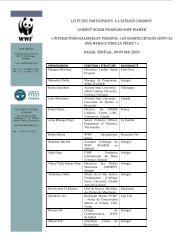Little Fish, Big Impact Summary - Lenfest Ocean Program
Little Fish, Big Impact Summary - Lenfest Ocean Program
Little Fish, Big Impact Summary - Lenfest Ocean Program
You also want an ePaper? Increase the reach of your titles
YUMPU automatically turns print PDFs into web optimized ePapers that Google loves.
To date, scientific guidance for managing forage fisheries has mostly focused on broad<br />
principles. The <strong>Lenfest</strong> Forage <strong>Fish</strong> Task Force report makes specific recommendations that<br />
fisheries managers can use to improve the sustainability of forage fisheries.<br />
Cut forage fishing by half in many ecosystems<br />
According to the Task Force’s food web simulations, the only fishing strategies that reliably<br />
sustain predators and forage populations are those that reduce maximum fishing mortality<br />
to half the conventional maximum. The most sustainable of these strategies also doubled the<br />
minimum biomass that should be left in the ocean to 40 percent of the unfished biomass—<br />
twice the conventional minimum.<br />
the task Force therefore recommends that, in most ecosystems, fishing should be<br />
half the conventional rate or less and leave at least twice as many forage fish in<br />
the ocean.<br />
little fish <strong>Big</strong> iMpact<br />
Recommendations<br />
Tailor management to available information<br />
The recommendation to cut fishing to half the conventional maximum assumes that there<br />
is sufficient information about forage fish and their interactions with predators and the<br />
environment to assess the impact of fishing. The Task Force expects that most forage<br />
fisheries now considered well-managed will fall into the “intermediate information tier.”<br />
However, managers may have very little information about certain “low information tier”<br />
fisheries. For these, the Task Force recommends fishing be severely restricted to maintain<br />
at least 80 percent of estimated unfished forage biomass in the ocean. In contrast, fisheries<br />
in the “high information tier” may be able to fish more aggressively, although they should<br />
maintain at least 30 percent of unfished biomass to account for uncertainty.<br />
The Task Force developed a full suite of recommendations based on these tiers. The figure to<br />
the right summarizes its recommended fishing limits and minimum biomasses for these tiers,<br />
and the table on the following pages provides detailed definitions and recommendations.<br />
6



